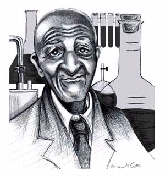George Carver
In the 1880s, agriculture began to be taken seriously as a science. George Washington Carver (1865-1943), born the slave of Missouri landowner Moses Carver, overcame the prejudices that did not die with the Emancipation Proclamation and became the foremost agricultural chemist of this new era. Through his innovations, Carver almost single-handedly revitalized the economy of the South.
Carver entered Simpson College intending to major in art, but he changed his focus to agriculture because art "would not do [his] people as much good." He went on to gain a BS (1894) and MS (1897) from Iowa State College of Agriculture and Mechanical Arts – an astonishing achievement, since these were "white" institutions. The already famous Carver was then invited by Booker T. Washington to head the first agricultural experimental station at the Tuskegee Institute.
Over the next thirty years, Carver developed essential methods of crop rotation. Cultivating nitrate-producing legumes as well as nutrient-consuming cotton in the same fields in alternate years kept the soil productive. In order for these legumes to be profitable, Carver invented hundreds of uses for sweet potatoes, cowpeas, soybeans, and especially peanuts (325 different uses, from cooking oil to printer's ink!). Carver also promoted organic fertilization. His plowing under of compost into one field resulted in a one hundred-fold increase in productivity.
As an educator as well as an inventor, Carver shared his discoveries with the farmers of the South. His innovations and determination impressed everyone who heard his ideas, and by the time of his death in 1943, he was already a legend.
Click here to read more about George Washington Carver.


